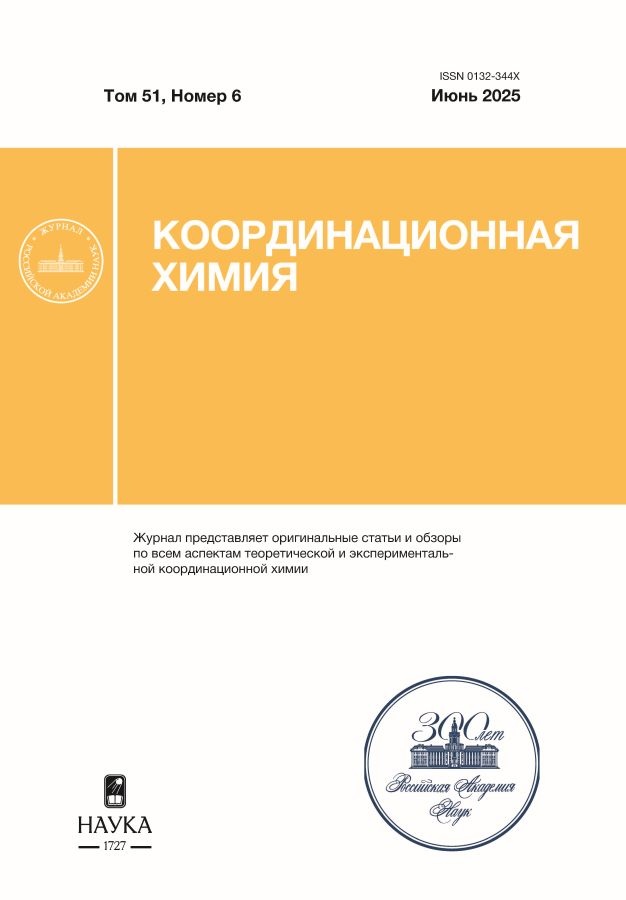On the Interaction of Copper(II) Complexes Cu(Gly)₂⁰, Cu(Bipy)Gly⁺, and Cu(Bipy)₂²⁺ with Glutathione
- Autores: Mironov I.V.1, Kharlamova V.Y.1
-
Afiliações:
- Nikolaev Institute of Inorganic Chemistry, Siberian Branch, Russian Academy of Sciences
- Edição: Volume 51, Nº 6 (2025)
- Páginas: 377-386
- Seção: Articles
- URL: https://ruspoj.com/0132-344X/article/view/687253
- DOI: https://doi.org/10.31857/S0132344X25060033
- EDN: https://elibrary.ru/KILFPQ
- ID: 687253
Citar
Texto integral
Resumo
The interaction of three copper(II) complexes — Cu(Gly)₂⁰, Cu(Bipy)₂²⁺, and Cu(Bipy)Gly⁺ — with glutathione in aqueous solution (pH 7.4, 0.2 M NaCl, 25°C, сCu = (1–10) × 10–4, сGSH = 1.0 × 10–3 M) was studied. These and similar complexes are often used in biological experiments to test anticancer and antimicrobial activity. It was shown that under physiological conditions copper(II) complexes are almost irreversibly converted into a more stable form of copper(I) thiolate complexes. The individuality of the initial complexes is completely lost. In all cases, the redox interaction of the copper(II) complexes with glutathione was rapid and quantitative. The main products were copper(I) bisthiolate complex and glutathione disulfide.
Palavras-chave
Texto integral
Sobre autores
I. Mironov
Nikolaev Institute of Inorganic Chemistry, Siberian Branch, Russian Academy of Sciences
Autor responsável pela correspondência
Email: imir@niic.nsc.ru
Rússia, Novosibirsk
V. Kharlamova
Nikolaev Institute of Inorganic Chemistry, Siberian Branch, Russian Academy of Sciences
Email: imir@niic.nsc.ru
Rússia, Novosibirsk
Bibliografia
- Freedman J.H., Ciriolo M.R., Peisach J. // J. Biol. Chem. 1989. V. 264. № 10. P. 5598.
- Кошенскова К.А., Баравиков Д.Е., Нелюбина Ю.В. и др. // Коорд. химия. 2023. Т. 49. № 10. С. 632. https://doi.org/10.31857/S0132344X23600212 (Koshenskova K.A., Baravikov D.E., Nelyubina Yu.V. et al. // Russ. J. Coord. Chem. 2023. V. 49. № 10. P. 660) https://doi.org/10.1134/S1070328423600730
- Śliwa E.I., Śliwińska-Hill U., Bażanów B. et al. // Molecules. 2020. V. 25. № 3. P. 741.
- Ruiz-Azuara L., Bravo-Gómez M.E. // Curr. Med. Chem. 2010. V. 17. P. 3606.
- Eremina J.A., Lider E.V., Kuratieva N.V. et al. // Inorg. Chim. Acta. 2021. V. 516. Art. 120169.
- Shakirova O.G., Morozova T.D., Kudyakova Y.S. et al. // Int. J. Mol. Sci. 2024. V. 25. P. 9414.
- Eremina J.A., Smirnova K.S., Klyushova L.S. et al. // J. Mol. Struct. 2021. V. 1245. Art. 131024.
- Speisky H., Gómez M., Carrasco-Pozo C. et al. // Bioorg. Med. Chem. 2008. V. 16. P. 6568.
- Galindo-Murillo R., García-Ramos J.C., Ruiz-Azuara L. et al. // Nucleic Acids Res. 2015. V. 43. № 11. P. 5364.
- Casini A., Kelter G., Gabbiani C. et al. // J. Biol. Inorg. Chem. 2009. V. 14. P. 1139.
- Gorini G., Magherini F., Fiaschi T. et al. // Biomedicines. 2021. V. 9. P. 871.
- Fernandez-Moreira V., Herrera R.P., Gimeno M.C. // Pure. Appl. Chem. 2018. V. 91. P. 247.
- Mironov I.V., Kharlamova V.Yu. // ChemistrySelect. 2023. V. 8. Art. e202301337.
- Миронов И.В., Харламова В.Ю. // Журн. неорган. химии. 2023. Т. 68. № 10. С. 1495. https://doi.org/10.31857/S0044457X23600639 (Mironov I.V., Kharlamova V.Yu. // Russ. J. Inorg. Chem. 2023. V. 68. № 10. P. 1487). https://doi.org/10.1134/S003602362360185X
- Crmarić D., Bura-Nakić E. // Molecules. 2023. V. 28. P. 5065.
- Rigo A., Corazza A., di Paolo M.L. et al. // J. Inorg. Biochem. 2004. V. 98. P. 1495.
- Smith R.C., Reed V.D., Hill W.E. // Phosphorus, Sulfur, Silicon Relat. Elem. 1994. V. 90. P. 147.
- Карякин Ю.В., Ангелов И.И. Чистые химические вещества. М.: Химия, 1974. С. 235.
- Bratsch S.G. // J. Phys. Chem. Ref. Data. 1989. V. 18. № 1. P. 1.
- Jocelyn P.C. // Eur. J. Biochem. 1967. V. 2. P. 327.
- Walsh M.J., Ahner B.A. // J. Inorg. Biochem. 2013. V. 128. P. 112.
- Österberg R., Ligaarden R., Persson D. // J. Inorg. Biochem. 1979. V. 10. P. 341.
- Königsberger L.-C., Königsberger E., Hefter G. et al. // Dalton Trans. 2015. V. 44. P. 20413.
- Perrin D.D. Stability сonstants of metal-ion complexes. Pt B: Organic ligands. New York: Pergamon Press, 1979. 1263 p.
- Speisky H., Gómez M., Burgos-Bravo F. et al. // Bioorg. Med. Chem. 2009. V. 17. P. 1803.
- Ngamchuea K., Batchelor-McAuley C., Compton R.G. // Chem. Eur. J. 2016. V. 22. № 44. P. 15937.
- Drochioiu G., Ion L., Ciobanu C. et al. // Eur. J. Mass Spectrom. 2013. V. 19. P. 71.
- Aliaga M.E., López-Alarcón C., Bridi R. et al. // J. Inorg. Biochem. 2016. V. 154. P. 78.
- Багиян Г.А., Королева И.К., Сорока Н.В. и др. // Кинетика и катализ. 2004. Т. 45. № 3. С. 398 (Bagiyan G.A., Koroleva I.K., Soroka N.V. et al. // Kinet. Catal. 2004. V. 45. № 3. P. 372). https://doi.org/10.1023/B:KICA.0000032171.81652.91
- Mejia C., Ruiz-Azuara L. // Pathol. Oncol. Res. 2008. V. 14. P. 467.
- Griesser R., Sigel H. // Inorg. Chem. V. 9. № 5. P. 1238.
- Raydan D., Rivas-Lacre I.J., Lubes V. et al. // J. Mol. Liq. 2020. V. 302. Art. 112595.
- Seko H., Tsuge K., Igashira-Kamiyama A. et al. // Chem. Commun. 2010. V. 46. P. 1962.
- Huang R., Wallqvist A., Covell D.G. // Biochem. Pharmacol. 2005. V. 69. P. 1009.
Arquivos suplementares
















